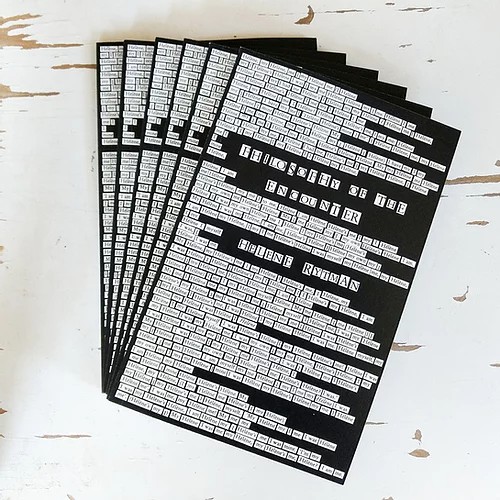
After strangling his wife, sociologist Hélène Rytmann, in their Paris apartment, Marxist philosopher Louis Althusser authored a memoir depicting the episode. The Future Lasts Forever was published in 1992. Almost three decades later, artist Tatiana Istomina tackles the narrative from the perspective of Rytmann. Her Fhilosofhy of the Encounter is ostensibly by Rytmann (Istomina is listed as the editor)—a Rytmann descending with a pen and a pair of scissors upon her husband’s book.
The result is a dizzying objet d’art; Althusser’s words are dislodged and collaged, erased and replaced, until a new and hypnotic voice emerges. This voice, presumably Rytmann’s, is alternately charged and mechanical, tender and cruel. Pages striped with redactions suggest eye-black reducing the glare of trauma. Rytmann, however, is relentless in unveiling it, beginning with the murder scene:
Suddenly, Louis was terror-struck. My eyes stared interminably, and he noticed the tip of my tongue was showing between my teeth and lips, strange and still.
This gorgonesque image, introduced on the first page, begins to invert Rytmann’s victimhood. What snakes out from this “head” are time’s tendrils, from Rytmann’s memories of her life with Althusser to the aftermath of the murder. The emotional topography of these vignettes—supported by the physical configuration of cut-out words on the page—becomes increasingly elliptical and compulsive. The effect is almost mathematical, though the math be eerie and glitch-prone. At one point, we are advised that “2 + 2 = 4 was true only in terms of a bourgeois ideology.” We are also asked to consider the following unsettling equation (in an intact passage from The Future Lasts Forever, with only the pronoun modified).
The fact is: for the first time my own death and his were fused. They were one and the same death—the cause might be different but the end product would be the same.
Though several psychoanalytic readings of the murder are proffered towards the end, Fhilosofhy of the Encounter makes clear that no lens can reveal the actual “why” of the act. Forget “death of the author”—even the death of the author’s wife is not enough to liberate the truth. Still, Istomina’s tack of setting Rytmann’s voice in dialectic with Althusser’s strikes me as powerful. This poetic work wilily resonates with Althusser’s philosophical work, given the latter’s intellectual heritage from Hegel. As Rytmann says of her husband:
He had a definite ability for establishing theoretical oppositions, which enabled him to reconstruct what he took to be an author’s ideas by drawing contrasts and distinctions.
And even if Istomina’s reconstruction is incomplete or imperfect (as all reconstructions must be), she grants Rytmann a poignant dignity in appropriating Althusser’s words for her own.
Anyway, I interpret this public account of my life as a way of taking responsibility again for myself, my grief, and my story. As they said in ancient times, it is an actus essendi: an act of being.’
In the deftness of its reclamation, Fhilosofhy of the Encounter recalls Chase Berggrun’s 2018 hit, R E D, a book of erasure poetry based on Bram Stoker’s Dracula which positions one of Dracula’s victims as the narrator. Fans of R E D will find much to appreciate in Istomina’s haunting text.
Lastly, a word must be said for the physical loveliness of the print. With slick pages, ink verging on Vantablack, and marvelous trompe-l’oeil collaging effects, Fhilosofhy of the Encounter forbids the reader to divorce the text from its material container. This feels like one more way of conjuring Rytmann—offering her a body, along with a voice.
***
Fhilosofhy of the Encounter
by Hélène Rytman and Tatiana Istomina
Pinsapo
Follow Vol. 1 Brooklyn on Twitter, Facebook, and sign up for our mailing list.
